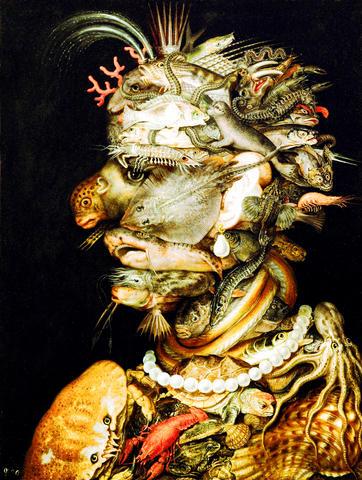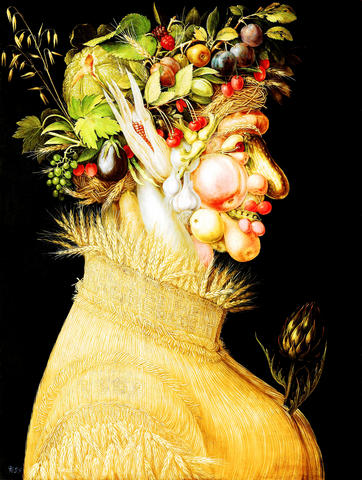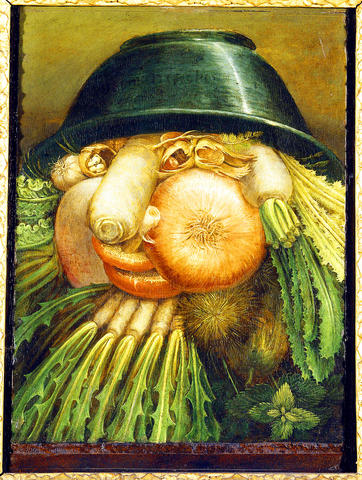Aside from World Cup rugby and Velib, the self-service bike-sharing program that at the moment seems to obsess le tout Paris, the most amusing cultural diversion here is the Giuseppe Arcimboldo exhibition at the Musee du Luxembourg.
Around the city, kiosks advertise fashion magazines offering advice to young women on how to flirt at Velib parking stations (with hair aptly wind-swept, feign difficulty with the automated pay system whenever a desirable man appears), and they also display colorful posters of puffy-cheeked faces made out of corn, pickles, garlic and cherries to promote Arcimboldo, the 16th-century Italian gimmick painter.
I had my doubts. But it turns out that the show's a charmer, not too shallow, admirably concise, almost chic. The glad mobs, forming polite, cheerful scrums before these stately paintings of people with vegetable faces and fish eyes seem to recognize in Arcimboldo something of the French impulse to bring order to everything.

PHOTO: NY TIMES NEWS SERVICE
There is a temptation to find in the show's popularity a metaphor for the general mood here. France's hyperactive president, Nicolas Sarkozy, has embarked on a campaign of economic transition and tough love. He is pushing a new French globalism in lieu of the comfortable old welfare system that has guaranteed early retirement and many other benefits, along with high unemployment, especially among disenfranchised immigrants, to whom he has done conspicuously little to endear himself.
Arcimboldo's subject was the instability of life, its changeability in a widening world. His purpose was to inspire a fresh but not always entirely comforting sense of possibility and wonderment. Mercantile conquests by 16th-century European powers, France included, uncovered new continents, from which an ear of corn, exotic and rare, could serve not just as a visual pun for a human ear but also as a political symbol of faraway places, economies, peoples - of nature itself - brought to heel.
That said, I would hazard that the general horde of visitors, a good percentage of whom seem to be strapped into strollers and under 1m tall, don't dwell on metaphorical meanings. They wait in a long line that every day snakes out the front door of the museum into the Luxembourg Gardens, where parents dragoon reluctant children from the ancient carousel and pony rides out of the autumn sunshine toward the show, girded by the assuring sight of happy families exiting it.

PHOTO: NY TIMES NEWS SERVICE
Mr. Fruit Face, as a friend of mine disdainfully calls him, has always been a guaranteed hit with the Transformers-age crowd. But his art is more serious and self-important than that. You can imagine him to have been the sort of initially jocular, learned dinner party companion whose arrogance makes itself known by the salad course. That he inspired thousands of appalling 20th-century Surrealists, apparently shocked at the genius of conceiving a gherkin to replace a nose, or a rose a cheek, isn't his fault.
Born in Milan in 1536, the son of a local artist, he started out painting conventional, darkling portraits. They're brittle but deft. He paid obeisance to Leonardo da Vinci via intermediaries like Bernardino Luini, who is said to have been a family friend. Commissions for stained glass and tapestries, permitting minor flights of peculiar fancy, eventually landed him in the employ of Maximilian II, in Vienna, then of Maximilian's cultivated son, Rudolf II.
There, he finally cooked up his famous faces. They satisfied a taste for exoticism. This was the era of high humanist curiosity. Newly rediscovered ancient texts like Pliny's Natural History circulated among scholars and artists; in the show, Archimbold's watercolors of animals and fish, exacting models he adapted for parts of faces, show him to be firmly grounded in science and real observation. Global exploration and advances in fields like optics and engineering stirred Rudolf, like other enlightened patrons, to wish to possess whatever was the rarest, the finest, the strangest, the most inexplicable art and artifacts. From such cabinets of curiosities - attempts to catalog and rationalize the irrational - evolved, one day, the modern museum. This was Arcimboldo's milieu and motivation.

PHOTO: NY TIMES NEWS SERVICE
Usefully, the show includes more than a few works by sculptors and decorators who also catered to a fixation on the marvelous. Coconuts, conch shells, ostrich eggs and coral, gathered from the distant corners of the earth, become goblets, bowls and hilts for swords, three-dimensional versions of his painted faces. They're about art's roots in mysticism and magic. Painting itself is a sleight-of-hand trick, after all: colored dirt becomes an illusion.
Along which lines Arcimboldo clearly picked up pointers from Bosch and no doubt from Persian miniaturists. A gorgeous show of classic Iranian art happens to have just opened at the Louvre, and it includes several astonishing paintings from Arcimboldo's time: fantastical landscapes populated by wild creatures. Stare at the mountain scenes, and faces can begin to suggest themselves in the salt-taffy rock formations and trees.
All artists have their niches, and this commonplace slip of the mind became for Arcimboldo a virtual cottage industry. A bust of a bearded librarian, with a tin-man face made of books, and bookmarks for fingers, is a clever feat of virtuosity, like the reversible pictures he painted: right side up, they're still lifes; upside down, portraits.

PHOTO: NY TIMES NEWS SERVICE
More interestingly, he also painted a three-quarter view of an old man, who, grossly desiccated, is memorably perverse by being somehow still dignified, almost courtly, in his dotage with branch stumps for stubble. Or there is the portrait of a German jurist, the humanist Johann Ulrich Zasius, with a plucked chicken for a head, a fish's mouth and a fish-tail chin. It's scary in ways that can almost remind you of Velazquez's portrait of Pope Innocent X, troubling the mind like a half-remembered nightmare.
So too are a quartet of stiff, plain-spoken little portraits of the family of Pedro Gonzalez. Their distinction was to grow hair all over their faces like the Wolf Man, an accident of nature akin to the Virgin Mary's portrait appearing in a grilled-cheese sandwich.
The universe concocts such marvels, which man emulates through art and industry in hopes to best it. That was Arcimboldo's bottom-line goal. His ambition, so frank and intellectual, gives to his prankish, often grotesque work its stylish hauteur.
Come to think of it, no wonder the French love him.

US President Donald Trump may have hoped for an impromptu talk with his old friend Kim Jong-un during a recent trip to Asia, but analysts say the increasingly emboldened North Korean despot had few good reasons to join the photo-op. Trump sent repeated overtures to Kim during his barnstorming tour of Asia, saying he was “100 percent” open to a meeting and even bucking decades of US policy by conceding that North Korea was “sort of a nuclear power.” But Pyongyang kept mum on the invitation, instead firing off missiles and sending its foreign minister to Russia and Belarus, with whom it

Many people noticed the flood of pro-China propaganda across a number of venues in recent weeks that looks like a coordinated assault on US Taiwan policy. It does look like an effort intended to influence the US before the meeting between US President Donald Trump and Chinese dictator Xi Jinping (習近平) over the weekend. Jennifer Kavanagh’s piece in the New York Times in September appears to be the opening strike of the current campaign. She followed up last week in the Lowy Interpreter, blaming the US for causing the PRC to escalate in the Philippines and Taiwan, saying that as

When Taiwan was battered by storms this summer, the only crumb of comfort I could take was knowing that some advice I’d drafted several weeks earlier had been correct. Regarding the Southern Cross-Island Highway (南橫公路), a spectacular high-elevation route connecting Taiwan’s southwest with the country’s southeast, I’d written: “The precarious existence of this road cannot be overstated; those hoping to drive or ride all the way across should have a backup plan.” As this article was going to press, the middle section of the highway, between Meishankou (梅山口) in Kaohsiung and Siangyang (向陽) in Taitung County, was still closed to outsiders

The Chinese Communist Party (CCP) has a dystopian, radical and dangerous conception of itself. Few are aware of this very fundamental difference between how they view power and how the rest of the world does. Even those of us who have lived in China sometimes fall back into the trap of viewing it through the lens of the power relationships common throughout the rest of the world, instead of understanding the CCP as it conceives of itself. Broadly speaking, the concepts of the people, race, culture, civilization, nation, government and religion are separate, though often overlapping and intertwined. A government